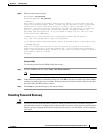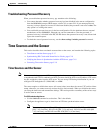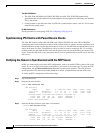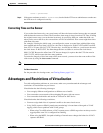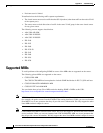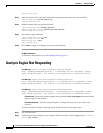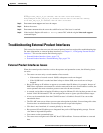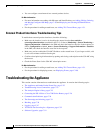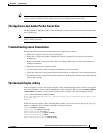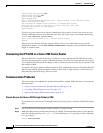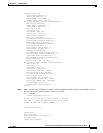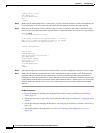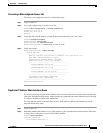
C-23
Cisco Intrusion Prevention System CLI Sensor Configuration Guide for IPS 7.1
OL-19892-01
Appendix C Troubleshooting
Troubleshooting External Product Interfaces
-----
MainApp N-2007_JUN_19_16_45 (Release) 2007-06-19T17:10:20-0500 Running
AnalysisEngine N-2007_JUN_19_16_45 (Release) 2007-06-19T17:10:20-0500 Not Running
CLI N-2007_JUN_19_16_45 (Release) 2007-06-19T17:10:20-0500
Step 3 Enter show tech-support and save the output.
Step 4 Reboot the sensor.
Step 5 Enter show version after the sensor has stabilized to see if the issue is resolved.
Step 6 If the Analysis Engine still reads Not Running, contact TAC with the original show tech support
command output.
Troubleshooting External Product Interfaces
This section lists issues that can occur with external product interfaces and provides troubleshooting tips.
For more information on external product interfaces, see Chapter 11, “Configuring External Product
Interfaces.” This section contains the following topics:
• External Product Interfaces Issues, page C-23
• External Product Interfaces Troubleshooting Tips, page C-24
External Product Interfaces Issues
When the external product interface receives host posture and quarantine events, the following issues
can arise:
• The sensor can store only a certain number of host records:
–
If the number of records exceeds 10,000, subsequent records are dropped.
–
If the 10,000 limit is reached and then it drops to below 9900, new records are no longer
dropped.
• Hosts can change an IP address or appear to use another host IP address, for example, because of
DHCP lease expiration or movement in a wireless network. In the case of an IP address conflict, the
sensor presumes the most recent host posture event to be the most accurate.
• A network can include overlapping IP address ranges in different VLANs, but host postures do not
include VLAN ID information. You can configure the sensor to ignore specified address ranges.
• A host can be unreachable from the CSA MC because it is behind a firewall. You can exclude
unreachable hosts.
• The CSA MC event server allows up to ten open subscriptions by default. You can change this value.
You must have an administrative account and password to open subscriptions.
• CSA data is not virtualized; it is treated globally by the sensor.
• Host posture OS and IP addresses are integrated into passive OS fingerprinting storage. You can
view them as imported OS profiles.
• You cannot see the quarantined hosts.
• The sensor must recognize each CSA MC host X.509 certificate. You must add them as a trusted
host.



